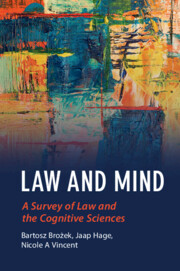Book contents
- Law and Mind
- Law and the Cognitive Sciences
- Law and Mind
- Copyright page
- Contents
- Figures
- Contributors
- Acknowledgements
- 1 Introduction
- I Metatheory and Methodology
- 2 Are the Cognitive Sciences Relevant for Law?
- 3 Social and Normative Facts
- 4 Law, Folk Psychology and Cognitive Science
- 5 Law and the Cognitive Science of Ordinary Concepts
- II Ontology and Epistemology
- III Legal Doctrine and Cognitive Sciences
- IV Evidence
- V Dissenting Opinions
- References
2 - Are the Cognitive Sciences Relevant for Law?
from I - Metatheory and Methodology
Published online by Cambridge University Press: 21 April 2021
- Law and Mind
- Law and the Cognitive Sciences
- Law and Mind
- Copyright page
- Contents
- Figures
- Contributors
- Acknowledgements
- 1 Introduction
- I Metatheory and Methodology
- 2 Are the Cognitive Sciences Relevant for Law?
- 3 Social and Normative Facts
- 4 Law, Folk Psychology and Cognitive Science
- 5 Law and the Cognitive Science of Ordinary Concepts
- II Ontology and Epistemology
- III Legal Doctrine and Cognitive Sciences
- IV Evidence
- V Dissenting Opinions
- References
Summary
This chapter addresses the question of whether the cognitive sciences are relevant for law. The answer to this question will turn out to be a threefold ‘yes’. First, if law is traditionally conceived as a set of rules that prescribe what ought to be done, there is a role for the cognitive sciences in determining the facts of the cases to which the law is to be applied (evidential reasoning). Legal decision making often involves the application of open-textured concepts, and the cognitive sciences can study the psychological processes and perhaps also the biases involved in such an application. Moreover, the results of the cognitive sciences may also be important for the evaluation of law, and for determining what good law might be.
A perhaps more ambitious role for cognitive sciences in law has to do with the determination of the content of the law. If law is a social phenomenon, and if social phenomena depend on what goes on in human minds, cognitive sciences can, at least in theory, study the content of the law. Some would argue that the cognitive sciences could never fulfil this more ambitious role, because law has to do with what OUGHT to be done, or ought to be the case, while sciences, including cognitive sciences, can only study what IS the case. It will be argued that this fundamental objection against this role for the cognitive sciences is misguided: there is no hard difference between IS and OUGHT and even if law belongs to the realm of OUGHT, cognitive sciences may still be relevant for determining the content of the law.
Finally, the cognitive sciences may disrupt the image of humankind that underlies law. It turns out that people are less rational than they may seem at first glance, that they often do not know what motivates them, that it is not obvious what actions and agents are and that it is unclear what the best level of explanation is for human actions or bodily movements. A change in the image of humankind that underlies law, to reflect the recent insights of the cognitive sciences but also of ancient philosophical debates, may have important consequences for the contents of law.
- Type
- Chapter
- Information
- Law and MindA Survey of Law and the Cognitive Sciences, pp. 17 - 49Publisher: Cambridge University PressPrint publication year: 2021



